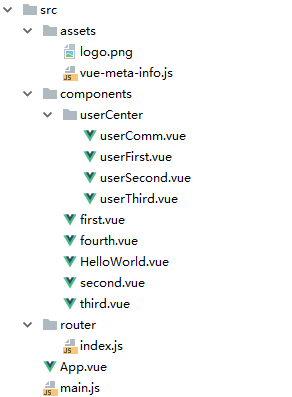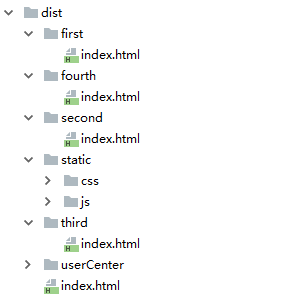https://blog.csdn.net/u012878818/article/details/90751461
vue cli SEO插件: prerender-spa-plugin
vue 项目预渲染(prerender-spa-plugin)
服务器端渲染 vs 预渲染 (SSR vs Prerendering)
如果你调研服务器端渲染 (SSR) 只是用来改善少数营销页面(例如 /, /about, /contact 等)的 SEO,那么你可能需要预渲染。无需使用 web 服务器实时动态编译 HTML,而是使用预渲染方式,在构建时 (build time) 简单地生成针对特定路由的静态 HTML 文件。优点是设置预渲染更简单,并可以将你的前端作为一个完全静态的站点。
如果你使用 webpack,你可以使用 prerender-spa-plugin 轻松地添加预渲染。它已经被 Vue 应用程序广泛测试 - 事实上,作者是 Vue 核心团队的成员。
三种不同渲染方式的区别:
客户端渲染:用户访问 url,请求 html 文件,前端根据路由动态渲染页面内容。关键链路较长,有一定的白屏时间;
服务端渲染:用户访问 url,服务端根据访问路径请求所需数据,拼接成 html 字符串,返回给前端。前端接收到 html 时已有当前url下的完整页面;
预渲染:构建阶段生成匹配预渲染路径的 html 文件(注意:每个需要预渲染的路由都有一个对应的 html)。构建出来的 html 文件已经有静态数据,需要ajax数据的部分未构建。
预渲染解决的问题:
SEO:单页应用的网站内容是根据当前路径动态渲染的,html 文件中往往没有内容,网络爬虫不会等到页面脚本执行完再抓取;
弱网环境:当用户在一个弱环境中访问你的站点时,你会想要尽可能快的将内容呈现给他们。甚至是在 js 脚本被加载和解析前;
低版本浏览器:用户的浏览器可能不支持你使用的 js 特性,预渲染或服务端渲染能够让用户至少能够看到首屏的内容,而不是一个空白的网页。
demo地址:https://github.com/hwq888/VUE-SSR/tree/prerender-spa-plugin
接下来我们实现下预渲染
-
vue-cli生成项目 (具体怎么构建请查相关资料)
-
配置prerender-spa-plugin
// 1、安装prerender-spa-plugin npm install prerender-spa-plugin --save-dev // 2、安装vue-meta-info npm install vue-meta-info --save-dev // 3、相关配置 <!-- webpack.prod.conf.js --> // 预渲染配置:在webpack.prod.conf文件中加入 const PrerenderSPAPlugin = require('prerender-spa-plugin') const Renderer = PrerenderSPAPlugin.PuppeteerRenderer // 在 plugins 中加入 new PrerenderSPAPlugin({ // 生成文件的路径,也可以与webpakc打包的一致。 // 下面这句话非常重要!!! // 这个目录只能有一级,如果目录层次大于一级,在生成的时候不会有任何错误提示,在预渲染的时候只会卡着不动。 staticDir: path.join(__dirname, '../dist'), // 对应自己的路由文件,比如a有参数,就需要写成 /a/param1。 routes: ['/', '/first', '/second', '/third', '/fourth', '/userCenter/userFirst','/userCenter/userSecond','/userCenter/userThird'], // 这个很重要,如果没有配置这段,也不会进行预编译 renderer: new Renderer({ inject: { foo: 'bar' }, // headless: false, renderAfterDocumentEvent: 'render-event', // 在 main.js 中 document.dispatchEvent(new Event('render-event')),两者的事件名称要对应上。 args: ['--no-sandbox', '--disable-setuid-sandbox'] }) }) // 4、在main.js中 import MetaInfo from 'vue-meta-info' new Vue({ el: '#app', router, components: { App }, template: '<App/>', // 添加mounted,不然不会执行预编译 mounted () { document.dispatchEvent(new Event('render-event')) } }) -
为了方便管理各个页面的标题、关键字和描述,创建vue-meta-info.js文件
export default { first: { title: '我是一个title[first]', meta: [ { name: 'keywords', content: '关键字1,关键字1,关键字1' }, { name: 'description', content: '这是一段网页的描述1' } ] }, second: { title: '我是一个title[second]', meta: [ { name: 'keywords', content: '关键字2,关键字2,关键字2' }, { name: 'description', content: '这是一段网页的描述2' } ] }, third: { title: '我是一个title[third]', meta: [ { name: 'keywords', content: '关键字3,关键字3,关键字3' }, { name: 'description', content: '这是一段网页的描述3' } ] } } -
相关路由文件:
import Vue from 'vue' import Router from 'vue-router' // import HelloWorld from '@/components/HelloWorld' import first from '@/components/first' import second from '@/components/second' import third from '@/components/third' import fourth from '@/components/fourth' import userComm from '@/components/userCenter/userComm' import userFirst from '@/components/userCenter/userFirst' import userSecond from '@/components/userCenter/userSecond' import userThird from '@/components/userCenter/userThird' Vue.use(Router) export default new Router({ <!-- 要用history模式 --> mode: 'history', routes: [ { path: '/', name: 'first', component: first }, { path: '/first', name: 'first', component: first }, { path: '/second', name: 'second', component: second }, { path: '/third', name: 'third', component: third }, { path: '/fourth', name: 'fourth', component: fourth }, { path: '/userCenter', component: userComm, meta: {name: '用户中心'}, children: [ {path: '/userCenter/userFirst', component: userFirst}, {path: '/userCenter/userSecond', component: userSecond}, {path: '/userCenter/userThird', component: userThird} ] } ] }) -
相关页面情况 https://github.com/hwq888/VUE-SSR/tree/prerender-spa-plugin


6. 生成的目录结构


7. 页面效果


8. 在研究过程中发现好几个疑难杂症:
1、在build生成静态文件之后,如果用router-link 跳转的话,刷新一下页面,a标签中的href发生变化(未解决)。
2、在config文件夹中index.js 如果把 assetsPublicPath 改成 相对路径 ./ build之后的文件路径不对(目前是 绝对路径 /)
3、prerender-spa-plugin 是基于 puppeteer 如果发现少了这个,手动安装一下(npm install puppeteer --save-dev)


评论区